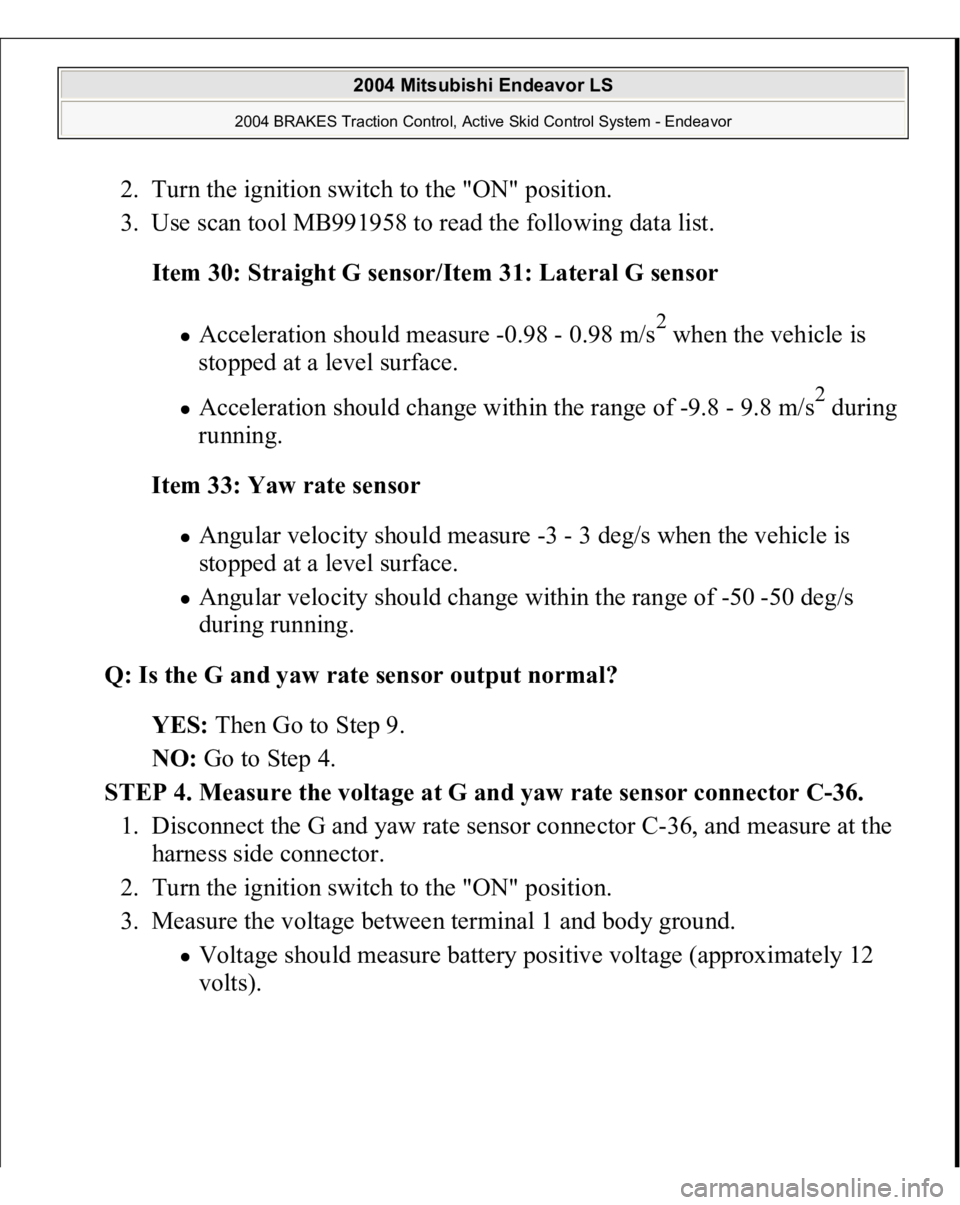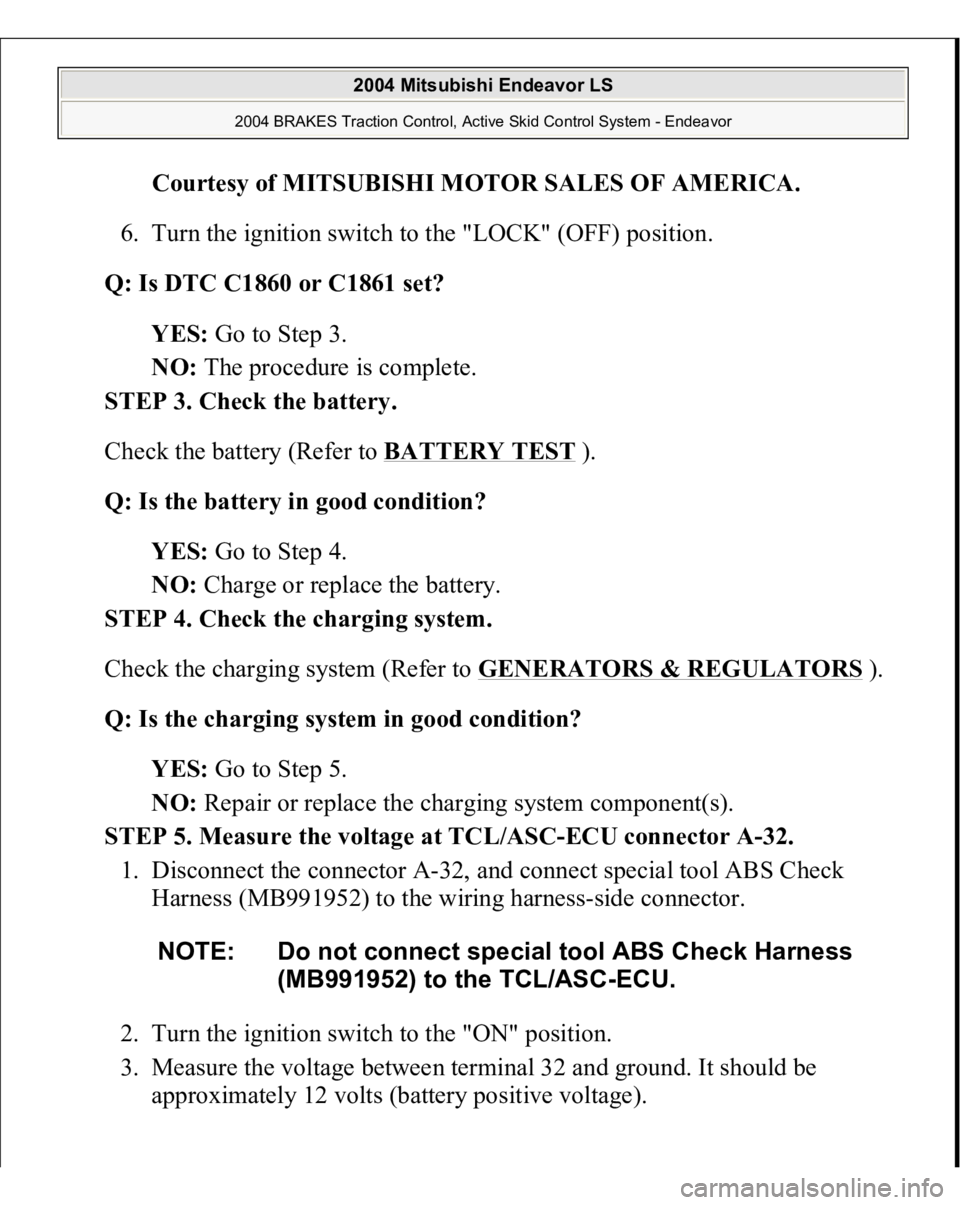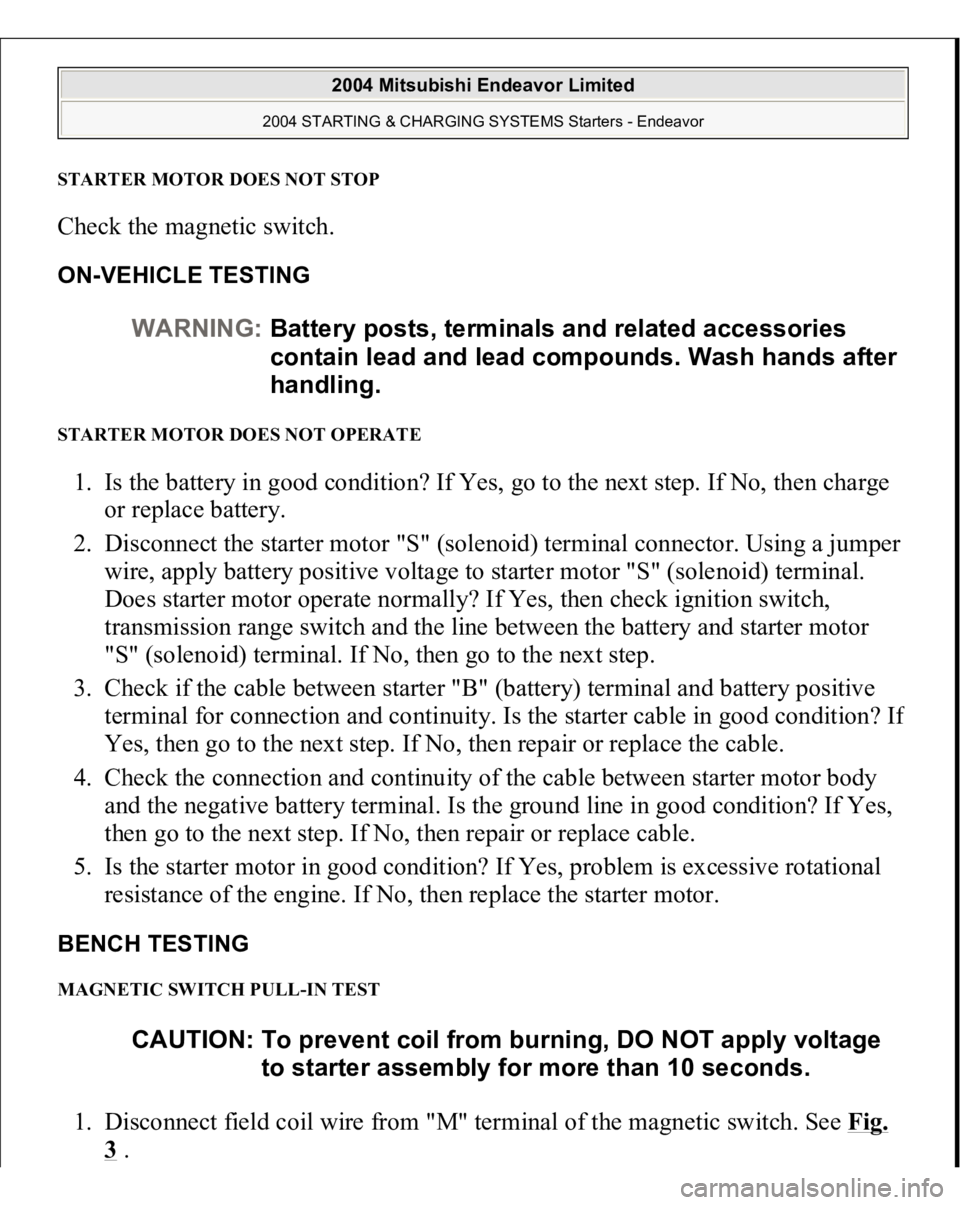Page 3285 of 3870
Q: Is the voltage approximately 12 volts (battery positive voltage)?
YES: Go to Step 5.
NO: Go to Step 4.
STEP 4. Check TCL/ASC-ECU connector A-32 for loose, corroded or
dama
ged terminals, or terminals
pushed back in the connector
.
2004 Mitsubishi Endeavor LS
2004 BRAKES Traction Control, Active Skid Control System - Endeavor
Page 3339 of 3870

2. Turn the ignition switch to the "ON" position.
3. Use scan tool MB991958 to read the following data list.
Item 30: Straight G sensor/Item 31: Lateral G sensor
Acceleration should measure -0.98 - 0.98 m/s
2 when the vehicle is
stopped at a level surface.
Acceleration should change within the range of -9.8 - 9.8 m/s
2 during
running.
Item 33: Yaw rate sensor
Angular velocity should measure -3 - 3 deg/s when the vehicle is
stopped at a level surface. Angular velocity should change within the range of -50 -50 deg/s
during running.
Q: Is the G and yaw rate sensor output normal?
YES: Then Go to Step 9.
NO: Go to Step 4.
STEP 4. Measure the voltage at G and yaw rate sensor connector C-36.
1. Disconnect the G and yaw rate sensor connector C-36, and measure at the
harness side connector.
2. Turn the ignition switch to the "ON" position.
3. Measure the voltage between terminal 1 and body ground. Voltage should measure battery positive voltage (approximately 12
volts
).
2004 Mitsubishi Endeavor LS
2004 BRAKES Traction Control, Active Skid Control System - Endeavor
Page 3399 of 3870

Courtesy of MITSUBISHI MOTOR SALES OF AMERICA
.
6. Turn the ignition switch to the "LOCK" (OFF) position.
Q: Is DTC C1860 or C1861 set?
YES: Go to Step 3.
NO: The procedure is complete.
STEP 3. Check the battery.
Check the battery (Refer to BATTERY TEST
).
Q: Is the battery in good condition?
YES: Go to Step 4.
NO: Charge or replace the battery.
STEP 4. Check the charging system.
Check the charging system (Refer to GENERATORS & REGULATORS
).
Q: Is the charging system in good condition?
YES: Go to Step 5.
NO: Repair or replace the charging system component(s).
STEP 5. Measure the voltage at TCL/ASC-ECU connector A-32.
1. Disconnect the connector A-32, and connect special tool ABS Check
Harness (MB991952) to the wiring harness-side connector.
2. Turn the ignition switch to the "ON" position.
3. Measure the voltage between terminal 32 and ground. It should be
approximately 12 volts (battery positive voltage). NOTE: Do not connect special tool ABS Check Harness
(MB991952) to the TCL/ASC-ECU.
2004 Mitsubishi Endeavor LS
2004 BRAKES Traction Control, Active Skid Control System - Endeavor
Page 3459 of 3870
Required Special Tools:
MB991958: Scan Tool (MUT-III Sub Assembly)
MB991824: Vehicle Communication Interface (V.C.I.) MB991827: MUT-III USB Cable MB991910: MUT-III Main Harness A
MB991952: ABS Check Harness
STEP 1. Measure the voltage at TCL/ASC-ECU connector A-32.
1. Disconnect the connector A-32, and connect special tool ABS Check
Harness (MB991952) to the wiring harness-side connector.
2. Turn the ignition switch to the "ON" position.
3. Measure the voltage between terminal 32 and ground. It should measure
approximately 12 volts (battery positive voltage). NOTE: Do not connect special tool ABS Check Harness
(MB991952) to the TCL/ASC-ECU.
2004 Mitsubishi Endeavor LS
2004 BRAKES Traction Control, Active Skid Control System - Endeavor
Page 3474 of 3870
1. Disconnect the connector C-312.
2. Turn the ignition switch to the "ON" position.
3. Measure the voltage between terminal 2 and ground. It should measure
approximately 12 volts (battery positive voltage).
2004 Mitsubishi Endeavor LS
2004 BRAKES Traction Control, Active Skid Control System - Endeavor
Page 3486 of 3870
Malfunction of the G and yaw rate sensor
DIAGNOSIS Required Special Tools:
MB991958: Scan Tool (MUT-III Sub Assembly)
MB991824: Vehicle Communication Interface (V.C.I.) MB991827: MUT-III USB Cable MB991910: MUT-III Main Harness A
MB991952: ABS Check Harness
STEP 1. Measure the voltage at G and yaw rate sensor connector C-36.
1. Disconnect the G and yaw rate sensor connector C-36, and measure at the
harness side connector.
2. Turn the ignition switch to the "ON" position.
3. Measure the voltage between terminal 1 and body ground.
Voltage should measure battery positive voltage (approximately 12
volts
).
2004 Mitsubishi Endeavor LS
2004 BRAKES Traction Control, Active Skid Control System - Endeavor
Page 3537 of 3870

STARTER MOTOR DOES NOT STOPCheck the magnetic switch. ON-VEHICLE TESTING STARTER MOTOR DOES NOT OPERATE 1. Is the battery in good condition? If Yes, go to the next step. If No, then charge
or replace battery.
2. Disconnect the starter motor "S" (solenoid) terminal connector. Using a jumper
wire, apply battery positive voltage to starter motor "S" (solenoid) terminal.
Does starter motor operate normally? If Yes, then check ignition switch,
transmission range switch and the line between the battery and starter motor
"S" (solenoid) terminal. If No, then go to the next step.
3. Check if the cable between starter "B" (battery) terminal and battery positive
terminal for connection and continuity. Is the starter cable in good condition? I
f
Yes, then go to the next step. If No, then repair or replace the cable.
4. Check the connection and continuity of the cable between starter motor body
and the negative battery terminal. Is the ground line in good condition? If Yes,
then go to the next step. If No, then repair or replace cable.
5. Is the starter motor in good condition? If Yes, problem is excessive rotational
resistance of the engine. If No, then replace the starter motor.
BENCH TESTING MAGNETIC SWITCH PULL-IN TEST 1. Disconnect field coil wire from "M" terminal of the magnetic switch. See Fig.
3 . WARNING:Battery posts, terminals and related accessories
contain lead and lead compounds. Wash hands after
handling.
CAUTION: To prevent coil from burning, DO NOT apply voltage
to starter assembly for more than 10 seconds.
2004 Mitsubishi Endeavor Limited
2004 STARTING & CHARGING SYSTEMS Starters - Endeavor
Page 3541 of 3870
Fig. 5: Magnetic Switch Return Test
Courtesy of MITSUBISHI MOTOR SALES OF AMERICA.
FREE RUNNING TEST 1. Place the starter motor in a vise equipped with soft jaws and connect a fully-
charged 12-volt battery to starter motor.
2. Connect a test ammeter (100-ampere scale) and carbon pile rheostat in series
between the positive battery terminal and starter motor terminal. See Fig. 6
.
3. Connect a voltmeter (15-volt scale) across the starter motor.
4. Rotate carbon
pile to full resistance
position.
2004 Mitsubishi Endeavor Limited
2004 STARTING & CHARGING SYSTEMS Starters - Endeavor